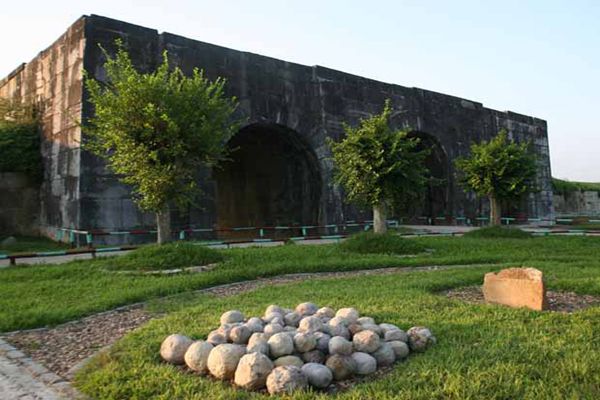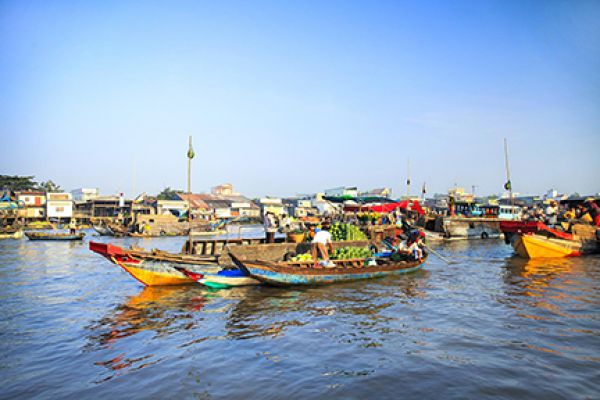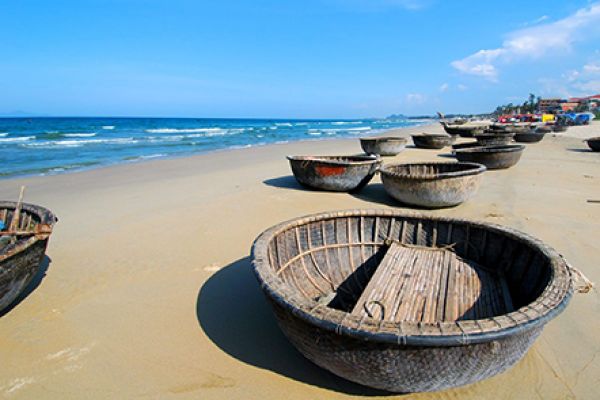Merry go round
While breezes are rustling the yellow stubbles remaining in the rice fields, the Muong in Hoa Binh are busy preparing for their New Rice Feast.
Bui Van Phuc, 66, in Muong Pieng village, Ngoc My commune, recalls that when he was a little boy, he liked to see his parents and other Muong families taking part in new rice feasts.
“The traditional feast started in feudal times,” he says. “Before doing the cooking, people must prepare high quality glutinous rice and fresh fish caught from the stream.”
Early in the morning, villagers send a young man into the forest to get cheo tree bark. Using a sharp knife, he whittles the bark off, then brings a bunch back to the village.
People use stones to beat the tree bark until its resin seeps out, then dip the bark into the stream.
“According to the Muong’s experience, this resin can make fish emerge. Then they simply use nets to catch them,” Phuc says.
The Muong process fish into three dishes: fish mixed with chilli, baked fish and fish cooked with bamboo shoots.
In contrast to the Kinh, whose women do most of the cooking, young men in the Muong community are in charge of preparing the food.
Meanwhile, a group of young women wearing traditional black skirts with white scarves round their heads and 1m-long narrow bamboo tubes over their shoulders walk up the stream to its source to get clean water for cooking.
In their houses on stilts Muong women help the men cook the steamed sticky rice and other dishes. Amid the sound of voices and laughter they use bamboo clips to bake fish over the fires and smoke keeps curling upwards over the rooftops.
 |
On behalf of villagers, Phuc, who is the village chief, prays for a new year with a bumper crop. He wishes everyone good health.
In the village yard young women hit the ground with bamboo tubes, making a series of thuds as if pounding rice.
One of them, Bui Thi Hien, says she feels very happy because this year her village harvested a bumper crop.
“That’s why we organise the new rice feast today. The feast demonstrates our national character and the traditions inherited from our ancestors,” she says.
In the bustling atmosphere, filled with the sound of gongs, people feel free to drink ruou can (local wine out of jars through bamboo straws).
“The present-day feast has been simplified with less quaint customs than in the old days,” Hien says. “Not long before, the Muong could not organise the new rice feast annually as it depended on whether their crops were successful or not.”
Credit where credit’s due
Bui Thi Tre, Chairwoman of the Kim Boi District People’s Committee, recalls that 10 years ago her district was very poor.
“We planted watermelon, up to 900ha of it. But both the crop and selling price were unstable. When we had a good crop, the selling price was low. When we had a poor crop, the price was high.”
Today, the Muong have undergone enormous changes, especially in their farming practice. In the past, many families only grew wet rice. Their crops often failed, due to unfavourable weather and geographic conditions. With assistance from local authorities, they decided to give up rice monoculture and shift to growing plants of high economic value.
Do Huy Ty’s family in Bac Son commune used to be hungry all year round. Since changing tact, the family has made a good profit from growing China squash.
“My family’s living conditions have much improved. We now have all essentials and things like TV sets and motorbikes.”
At first, Ty recalls, his family found it very trying to grow squash.
“Gradually we got used to growing it. Nowadays, many other families have followed our steps, and we are ready to help them out,” Ty says. “Being a veteran, I feel it my duty to be a front runner in this movement.”
Le Thi Nanh is another case in point. Her family has so far grown up to 3-4 ha of China squash.
“The initial capital needed is small, between VND5-6 million but we can earn a profit of VND30-40 million per year," she says.
In addition to growing China squash and watermelon, some families have signed contracts with dealers from other provinces to grow muop dang (colocynth or bitter apple) to exploit its seeds for medical purposes. Growing Colocynth requires sophisticated techniques throughout the process, from planting to nurturing saplings.
Farmer Pham Sy Lam has to use incandescent bulbs to heat his colocynth crop.
“It requires some 50 degree centigrade to develop well,” he says. “My family has 3,000sq.m of land. We used to grow maize and groundnut only. Recently we have switched to growing colocynth, as it can generate a higher profit. Now, we can earn VND80 million per year from our produce,” he says.
Chairwoman Bui Thi Tre says that over the years the focus of investment has been on developing local infrastructure and improving local people’s living standards.
“In particular, the production of squash and colocynth has continued to pay off. Each hectare can earn more than VND10 million, and a crop lasts five months only,” she says. “In Bac Son and some nearby communes, people know how to do intensive farming for a higher profit”.
The Muong have been trained in applying advanced farming techniques, and are now quite capable of raising pigs and cattle to improve their annual incomes.
Bui Thi Ha in Tra village, Ngoc Son commune, says the Muong have followed the authorities’ advice to shift from their rice monoculture to growing maize and raising pigs, and no families experience a high level of stress in their daily life anymore.
“Authorities have assisted my family with saplings, capital and techniques to improve our farming and livestock breeding. We no longer live in fear of hunger and are very happy to see our children going to school,” she says.
Like Ha’s, nearly 400 other Muong families in Ngoc Son Commune are also engaged in growing maize and raising pigs, cows and buffaloes.
Nguyen Duc Chung, Head of the provincial Nationalities and Religion Committee, says the number of poor Muong households in Hoa Binh has fallen dramatically from 40 percent in 2000 to 17 percent so far. He attributes this success to increasing investment in local infrastructure like irrigation, water supply, power, transport, education and healthcare projects.
Many years ago, Ngoc Son commune faced a serious shortage of water. Now there is enough water even for farming on a large scale.
Farmers like Hien and Ha believe that if the Muong give up their out-dated farming methods and shift to growing cash crops, they are sure to make a quick buck and have plenty of opportunity to celebrate their bumper harvest.










(84-63) 3 826042 – (84-63) 3 511142
No 54 Nguyen Dinh Chieu, Ham Tien Central Mui Ne Beach Binh Thuan Vietnam
523 To Hien Thanh District 10 Ho Chi Minh City Vietnam
Ha Long Halong City Quang Ninh Vietnam
A13 Hung Thong 2 Halong City Quang Ninh Vietnam




